24节气英文介绍
- 格式:ppt
- 大小:7.93 MB
- 文档页数:81
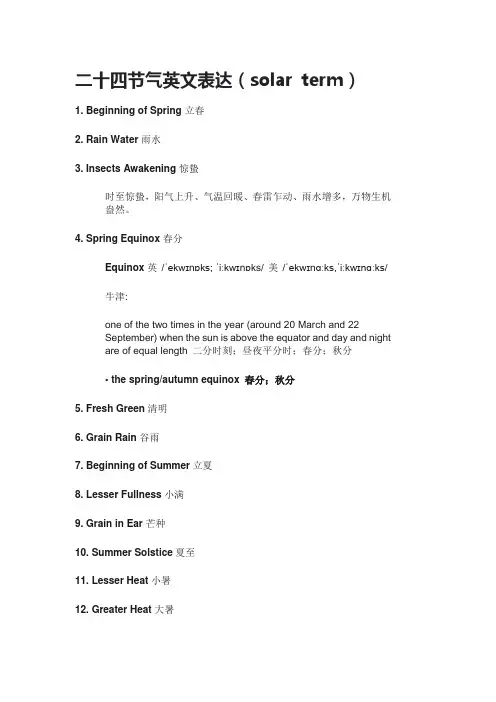
二十四节气英文表达(solar term)1. Beginning of Spring 立春2. Rain Water雨水3. Insects Awakening 惊蛰时至惊蛰,阳气上升、气温回暖、春雷乍动、雨水增多,万物生机盎然。
4. Spring Equinox 春分Equinox 英/ˈekwɪnɒks; ˈiːkwɪnɒks/ 美/ˈekwɪnɑːks,ˈiːkwɪnɑːks/牛津:one of the two times in the year (around 20 March and 22September) when the sun is above the equator and day and night are of equal length 二分时刻;昼夜平分时;春分;秋分•the spring/autumn equinox 春分;秋分5. Fresh Green清明6. Grain Rain 谷雨7. Beginning of Summer立夏8. Lesser Fullness小满9. Grain in Ear 芒种10. Summer Solstice夏至11. Lesser Heat小暑12. Greater Heat大暑13. Beginning of Autumn 立秋14. End of Heat 处暑15. White Dew白露16. Autumnal Equinox秋分17. Cold Dew寒露Dew 英/djuː/ 美/duː/ n. 珠,滴;露水;清新vt. (露水等)弄湿vi. 结露水18. First Frost 霜降19. Beginning of Winter立冬20. Light Snow小雪21. Heavy Snow大雪22. Winter Solstice冬至Solstice 英/ˈsɒlstɪs/ 美/ˈsɑːlstɪs/either of the two times of the year at which the sun reaches itshighest or lowest point in the sky at midday, marked by thelongest and shortest days 至(点);(夏或冬)至•the summer/winter solstice 夏至;冬至23. Lesser Colder小寒24. Greater Cold 大寒。
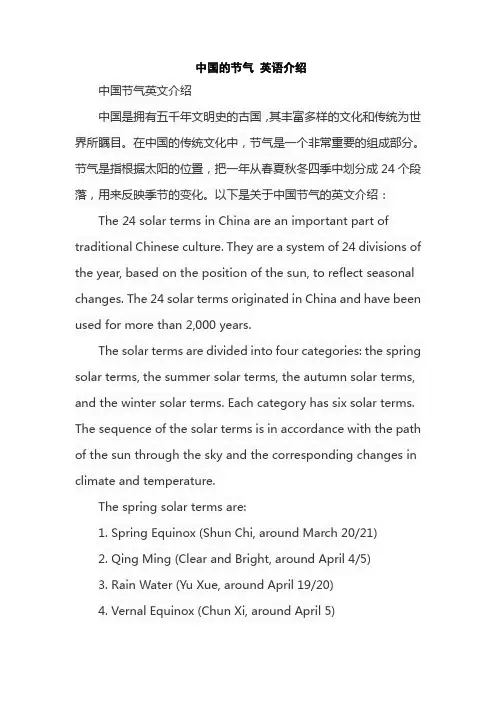
中国的节气英语介绍中国节气英文介绍中国是拥有五千年文明史的古国,其丰富多样的文化和传统为世界所瞩目。
在中国的传统文化中,节气是一个非常重要的组成部分。
节气是指根据太阳的位置,把一年从春夏秋冬四季中划分成24个段落,用来反映季节的变化。
以下是关于中国节气的英文介绍:The 24 solar terms in China are an important part of traditional Chinese culture. They are a system of 24 divisions of the year, based on the position of the sun, to reflect seasonal changes. The 24 solar terms originated in China and have been used for more than 2,000 years.The solar terms are divided into four categories: the spring solar terms, the summer solar terms, the autumn solar terms, and the winter solar terms. Each category has six solar terms. The sequence of the solar terms is in accordance with the path of the sun through the sky and the corresponding changes in climate and temperature.The spring solar terms are:1. Spring Equinox (Shun Chi, around March 20/21)2. Qing Ming (Clear and Bright, around April 4/5)3. Rain Water (Yu Xue, around April 19/20)4. Vernal Equinox (Chun Xi, around April 5)5. Grain Rain (Shu Yu, around April 20)6. Spring Begins (Chun Qi, around February 4)The summer solar terms are:1. Summer Solstice (Du Li, around June 21)2. Grain in Ear (Dao Yu, around June 5)3. Summer Begins (Xia Qi, around May 5)4. Dripping with Sweat (Si Shu, around June 20)5. Scalding Pot (Shuai Gu, around July 7)6. Slight Heat (Xiao Liang, around July 7)The autumn solar terms are:1. Autumn Equinox (Shu Chi, around September 23)2. Harvest Moon (Bai Qiu, around September 7)3. Autumn Begins (Qi Qi, around August 7)4. Cold Dew (Han Qi, around September 23)5. White Dew (Bai Yu, around October 8)6. Autumn Full Moon (Qiu Yuan, around October 8) The winter solar terms are:1. Winter Solstice (Dan Li, around December 21/22)2. Big Cold (Da Han, around December 7)3. Winter Begins (He Xi, around November 8)4. Frost's Descent (Shu Zhi, around November 23)5. Bracing Wind (Wu Liu, around January 5)6. Minor Heat (Xiao Liang, around January 5/6)。


二十四节气英语作文100词英文回答:The twenty-four solar terms are a traditional Chinese calendar that divides the year into 24 equal parts, each representing a different season or climatic period. The solar terms are based on the position of the sun in the sky and are used to guide agricultural activities and daily life.The twenty-four solar terms are:Spring:立春 (Lichun) Beginning of Spring.雨水 (Yushui) Rain Water.惊蛰 (Jingzhe) Awakening of Insects.春分 (Chunfen) Spring Equinox.清明 (Qingming) Clear and Bright.谷雨 (Guyu) Grain Rain.Summer:立夏 (Lixia) Beginning of Summer.小满 (Xiaoman) Grain Filling.芒种 (Mangzhong) Grain in Ear.夏至 (Xiazhi) Summer Solstice.小暑 (Xiaoshu) Minor Heat.大暑 (Dashu) Major Heat.Autumn:立秋 (Liqiu) Beginning of Autumn.处暑 (Chushu) End of Heat.白露 (Bailu) White Dew.秋分 (Qiufen) Autumn Equinox.寒露 (Hanlu) Cold Dew.霜降 (Shuangjiang) Frost's Descent. Winter:立冬 (Lidong) Beginning of Winter.小雪 (Xiaoxue) Minor Snow.大雪 (Daxue) Major Snow.冬至 (Dongzhi) Winter Solstice.小寒 (Xiaohan) Minor Cold.大寒 (Dahan) Major Cold.The twenty-four solar terms are an important part of Chinese culture and are still used today to guide agricultural activities and daily life.中文回答:二十四节气是中国传统历法中将一年等分为24个时段的划分方式,每个时段代表着不同的季节或气候。
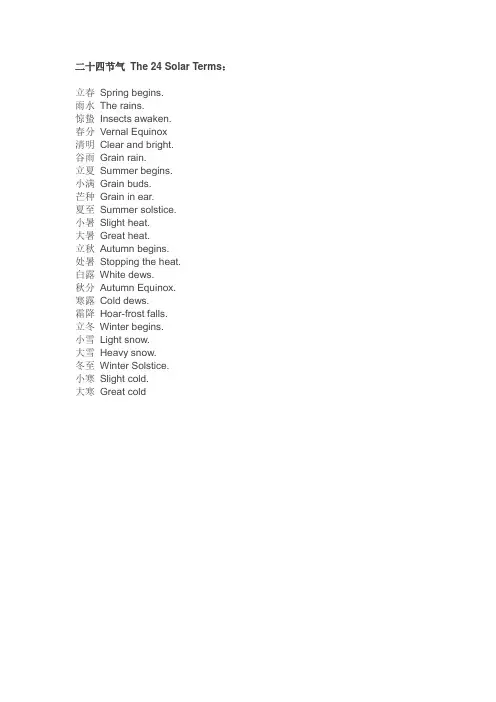
二十四节气The 24 Solar Terms:立春Spring begins.雨水The rains.惊蛰Insects awaken.春分Vernal Equinox清明Clear and bright.谷雨Grain rain.立夏Summer begins.小满Grain buds.芒种Grain in ear.夏至Summer solstice.小暑Slight heat.大暑Great heat.立秋Autumn begins.处暑Stopping the heat.白露White dews.秋分Autumn Equinox.寒露Cold dews.霜降Hoar-frost falls.立冬Winter begins.小雪Light snow.大雪Heavy snow.冬至Winter Solstice.小寒Slight cold.大寒Great cold以下无正文仅供个人用于学习、研究;不得用于商业用途。
For personal use only in study and research; not for commercial use.仅供个人用于学习、研究;不得用于商业用途。
Nur für den persönlichen für Studien, Forschung, zu kommerziellen Zwecken verwendet werden.Pour l 'étude et la recherche uniquement à des fins personnelles; pas à des fins commerciales.仅供个人用于学习、研究;不得用于商业用途。
толькодля людей, которые используются для обучения, исследований и не должны использоваться в коммерческих целях.For personal use only in study and research; not for commercial use。
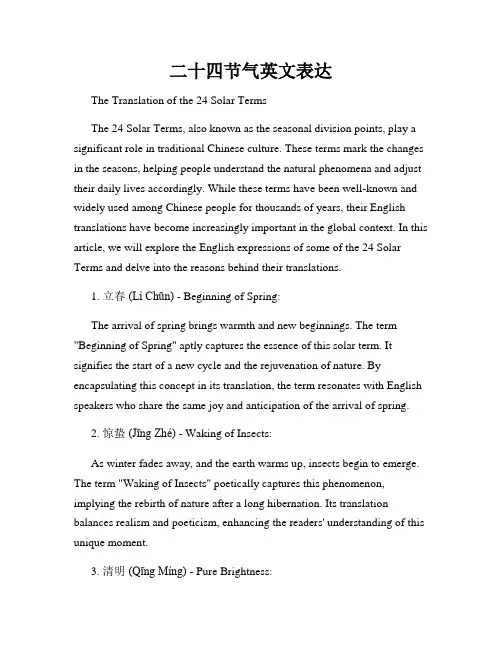
二十四节气英文表达The Translation of the 24 Solar TermsThe 24 Solar Terms, also known as the seasonal division points, play a significant role in traditional Chinese culture. These terms mark the changes in the seasons, helping people understand the natural phenomena and adjust their daily lives accordingly. While these terms have been well-known and widely used among Chinese people for thousands of years, their English translations have become increasingly important in the global context. In this article, we will explore the English expressions of some of the 24 Solar Terms and delve into the reasons behind their translations.1. 立春(Lì Chūn) - Beginning of Spring:The arrival of spring brings warmth and new beginnings. The term "Beginning of Spring" aptly captures the essence of this solar term. It signifies the start of a new cycle and the rejuvenation of nature. By encapsulating this concept in its translation, the term resonates with English speakers who share the same joy and anticipation of the arrival of spring.2. 惊蛰(Jīng Zhé) - Waking of Insects:As winter fades away, and the earth warms up, insects begin to emerge. The term "Waking of Insects" poetically captures this phenomenon, implying the rebirth of nature after a long hibernation. Its translation balances realism and poeticism, enhancing the readers' understanding of this unique moment.3. 清明(Qīng Míng) - Pure Brightness:In early April, the Pure Brightness solar term brings clear skies and bright sunshine. The term "Pure Brightness" reflects the essence of this period when nature is at its freshest, and everything appears clear and bright. Its translation conveys the visual imagery associated with this term, immersing the readers in the sense of tranquility and serenity that accompanies this season.4. 立夏 (Lì Xià) - Beginning of Summer:With summer approaching, the term "Beginning of Summer" precisely captures the transition from spring to summer. It symbolizes the onset of warmer weather, longer days, and a shift in daily routines. The translation resonates with English speakers who associate this time of the year with outdoor activities, celebrations, and vacations.5. 小满(Xiǎo Mǎn) - Grain Buds:During this period, crops begin to mature, and small grains appear on plants. The term "Grain Buds" effectively conveys the visual image of plants budding and crops thriving. The translation paints a vivid picture of fields filled with promise and abundance, enabling English readers to appreciate the importance of this seasonal milestone.6. 夏至 (Xià Zhì) - Summer Solstice:As the longest day of the year, the Summer Solstice brings heat and energy to the world. The term "Summer Solstice" encapsulates the astronomical significance of this solar term, making it universally understood across cultures and languages. Its translation allows Englishspeakers to relate to this exceptional day when the sun reaches its highest point in the sky.In conclusion, the translation of the 24 Solar Terms into English requires a careful consideration of cultural and natural elements. By capturing the essence of each term in its translation, we can bridge the gap between different languages and cultures, allowing people worldwide to appreciate and understand the beauty and significance of these seasonal milestones.。
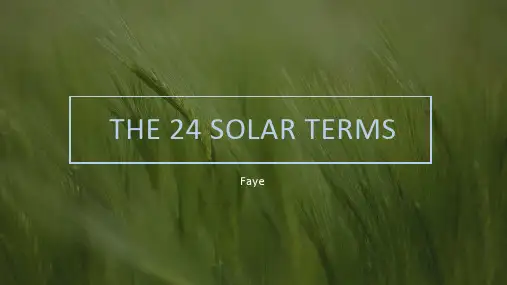
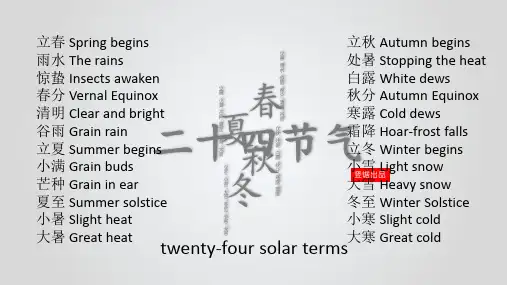

二十四节气英语作文英文回答:The 24 solar terms, also known as the 24 Chinese lunar terms, are a traditional way of dividing the year in China. Each term reflects the changing of seasons, weather patterns, and agricultural activities. The 24 solar terms are important in Chinese culture and are used to guide farming activities, traditional Chinese medicine practices, and even daily life.For example, the term "Lìqiū (立秋)" marks the beginning of autumn and is a time when people start to prepare for the upcoming harvest season. In my hometown, we would start to pick the ripe fruits and vegetables, and store them for the winter. It is also a time when we would start to make preparations for the Mid-Autumn Festival, which is a time for family reunions and enjoying the full moon.Another example is the term "Dàshǔ (大暑)" which signifies the hottest days of the year. During this time, people would take extra precautions to stay cool and hydrated. We would often say "Zhè shíjiān rè de bào,yào duō hē shuǐ, shǎo chū yīdiǎn" (这时间热得很,要多喝水,少出一点) which means "It's very hot at this time, drink more water and go out less."中文回答:二十四节气,也被称为二十四气,是中国传统的一种时间记法。
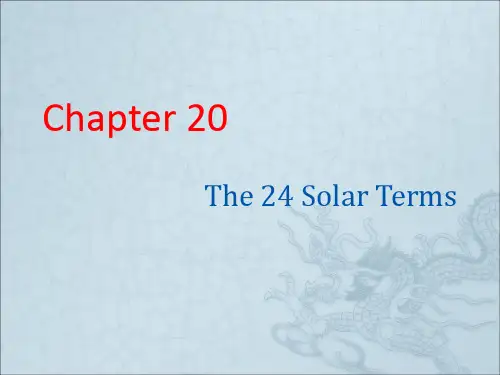
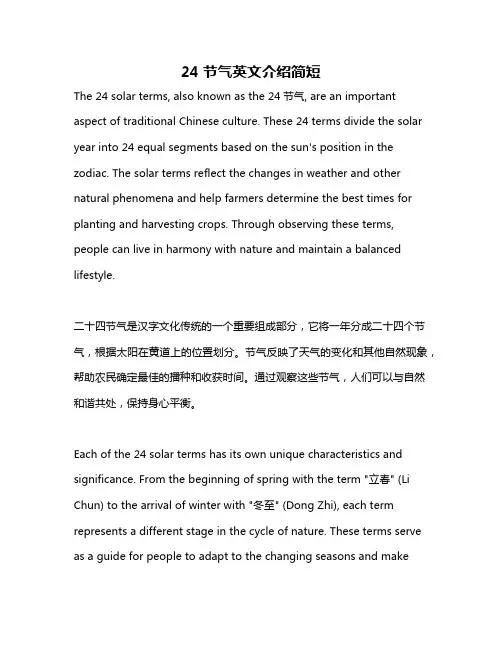
24节气英文介绍简短The 24 solar terms, also known as the 24节气, are an important aspect of traditional Chinese culture. These 24 terms divide the solar year into 24 equal segments based on the sun's position in the zodiac. The solar terms reflect the changes in weather and other natural phenomena and help farmers determine the best times for planting and harvesting crops. Through observing these terms, people can live in harmony with nature and maintain a balanced lifestyle.二十四节气是汉字文化传统的一个重要组成部分,它将一年分成二十四个节气,根据太阳在黄道上的位置划分。
节气反映了天气的变化和其他自然现象,帮助农民确定最佳的播种和收获时间。
通过观察这些节气,人们可以与自然和谐共处,保持身心平衡。
Each of the 24 solar terms has its own unique characteristics and significance. From the beginning of spring with the term "立春" (Li Chun) to the arrival of winter with "冬至" (Dong Zhi), each term represents a different stage in the cycle of nature. These terms serve as a guide for people to adapt to the changing seasons and makethe most of the environment around them. Understanding the subtle shifts in energy and temperature during each term can help individuals make the necessary adjustments in their daily lives.每个节气都有其独特的特点和意义。
节气英文介绍范文Chinese solar terms, also known as the 24 solar terms, are a traditional system used in China to divide the year into 24 segments based on the sun's movement and the changes in climate and natural phenomena. Each solar term is approximately 15 days long and has its unique characteristics and significance. They serve as an essential part of Chinese culture, providing guidance for agricultural activities, seasonal customs, and traditional festivals. In this essay, we will introduce the 24 solar terms, their meanings, and their cultural significance.4. Spring Equinox (春分): The sun crosses the celestial equator during this solar term, resulting in equal day and night lengths. It symbolizes the balance between light and darkness.6. Grain Rain (谷雨): As the last solar term of spring, this period is crucial for the growth of crops. The rainfall is beneficial for the germination and growth of grains.7. Start of Summer (立夏): This solar term marks the beginning of the summer season. The temperature starts to rise, and the rainfall increases.9. Grain in Ear (芒种): The seeds of the crops start to form into ears during this solar term. It is the stage where the crops begin to mature, and farmers need to take measures to prevent pests and diseases.10. Summer Solstice (夏至): This solar term is the longest day of the year, with the shortest night. It signifies the peak of summer and the arrival of hot weather.12. Major Heat (大暑): As the hottest period of the year, this solar term brings scorching temperatures. People often avoid outdoor activities during midday and take measures to stay cool.16. Autumnal Equinox (秋分): Similar to the spring equinox, this solar term represents the balance between light and darkness. The day and night are once again of equal length.19. Start of Winter (立冬): This solar term symbolizes the beginning of winter. The temperature drops significantly, and people need to start wearing warmer clothing to protect themselves from the cold.20. Minor Snow (小雪): The first snowfall typically occurs during this solar term. It signals the arrival of winter and the need to prepare for the colder weather.21. Major Snow (大雪): This solar term brings heavier snowfall and colder temperatures. It is essential for people to stay warm and take precautions against winter illnesses.22. Winter Solstice (冬至): Similar to the summer solstice, this solar term is the shortest day of the year with the longestnight. It signifies the peak of winter and the beginning of longer days.24. Major Cold (大寒): This solar term represents the coldest period of the year. The temperature drops significantly, and people need to take extra precautions to stay warm and protected.The 24 solar terms are deeply rooted in Chinese culture and have been followed for thousands of years. They not only guide agricultural activities but also serve as a reminder of the changes and cycles in nature. Additionally, they influence many traditional festivals and customs in China, providing a cultural framework for people to celebrate and appreciate the changing seasons. The 24 solar terms are considered an invaluable aspect of Chinese wisdom and heritage.。
介绍中国节气英文作文英文:As a Chinese person, I am proud of the traditional Chinese culture, which includes the 24 solar terms, also known as the 24节气(jié qì). The 24 solar terms are based on the changes in the sun's position in the sky andthe natural phenomena that occur during the year. Eachsolar term is associated with a specific date and marks a particular seasonal change.For example, the first solar term is 立春(lì chūn), which falls on February 4th or 5th. It marks the beginningof spring and the start of a new year in the lunar calendar. During this time, people in China often eat dumplings,which symbolize wealth and good fortune.Another solar term is 夏至(xià zhì), which falls on June 21st or 22nd. It marks the longest day of the year and the beginning of summer. People in China often eat 汤圆(tāng yuán), which are glutinous rice balls served in a sweet soup, to celebrate this solar term.There are many other solar terms, each with their own unique traditions and customs. As a Chinese person, I feel that the 24 solar terms are an important part of ourculture and heritage. They remind us of the changes in nature and help us to connect with the world around us.中文:作为一个中国人,我为传统的中国文化感到自豪,其中包括24节气。